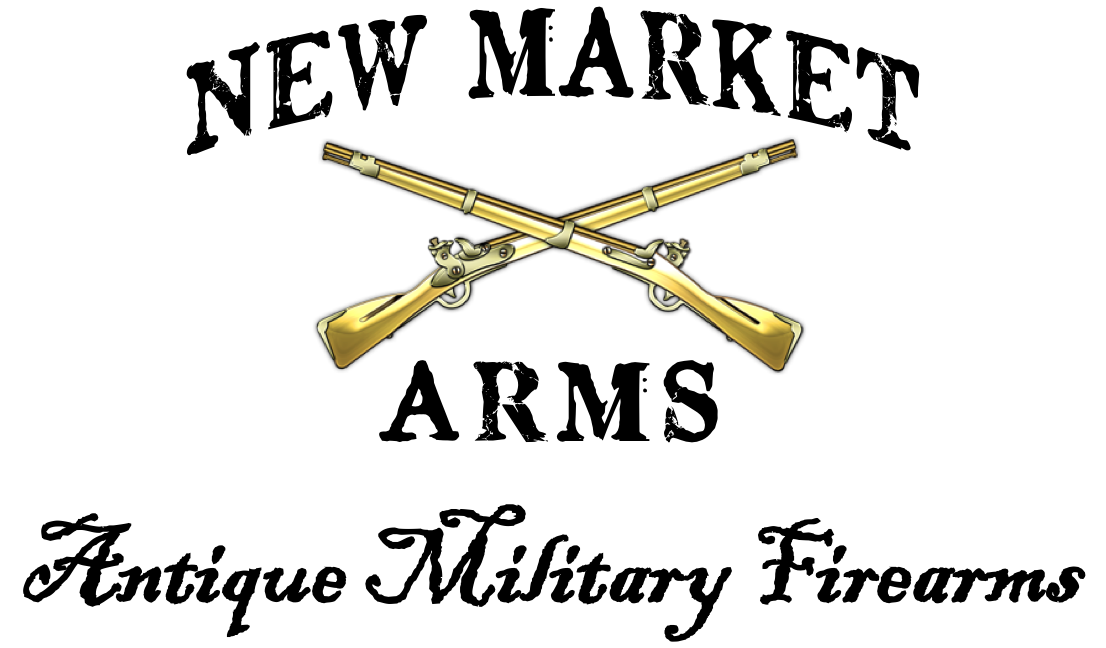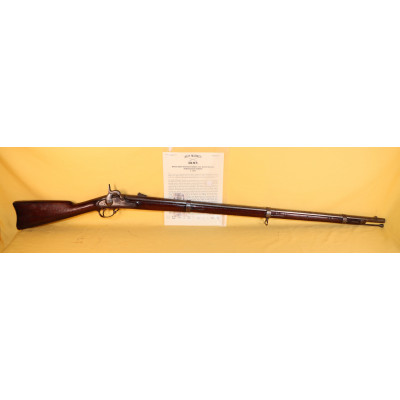Very Rare 1861-dated Civil War Springfield Model 1861 Rifle Musket
This is a very rare and untouched condition, original Civil War Springfield Armory Model 1861 Rifled Musket that was manufactured in 1861, the first year of the Civil War. 1861-dated Springfield Rifle Muskets are very rarely seen for sale.
The Model 1861 Rifle Musket was conceived on the eve of the Civil War to replace the Maynard priming system found on the previously issued arms. The Maynard priming system, while revolutionary in many ways, had several drawbacks that led to dissatisfaction with the system in the Model 1855 series of firearms. Because of reports from the field about the unreliability of the Maynard priming system, an Ordnance Board was convened in May 1860 under the direction of Major Alfred Mordecai. The Board's final recommendation was that "no more arms of this kind be made after those in progress are finished; but that all models of the rifled small arms should be made on the former simple system for using percussion caps alone, which are universally admitted to be efficient and reliable for service." This recommendation, and several others, were approved by the Secretary of War on February 20, 1861. The rifle musket meeting the Ordnance Department's new design specifications ordinarily would have been made at both of the U.S. Government's two national armories, Harpers Ferry Armory and Springfield Armory. Harpers Ferry would not produce the new rifle musket, however, because it was captured and partially destroyed by Virginia Militia forces on April 18, 1861.
Elisha K. Root from Colt met at Springfield Armory with Springfield's Master Armorer, Erskine S. Allin, in June 1861 to design the new rifle musket. The model rifle musket produced as a result was designated the Model 1861 Rifle Musket. The rapid call up of volunteers by President Lincoln in the spring of 1861 meant these new soldiers would need rifles. Although over 60,000 Model 1855 Rifle Muskets had been produced before the Civil War (with the Maynard priming system), an inventory completed on the eve of war showed that only 22,649 of these rifle muskets were in U.S. Government control (the balance having been distributed to the states or militias pursuant to the 1808 Militia Act or to the regular army). This left the new arm, the Model 1861, as the musket to be produced at Springfield and the urgent need for rifles meant that the Chief of Ordnance was frequently corresponding with the Superintendent at Springfield Armory encouraging him to increase production of the new rifle as quickly as possible. By way of comparison, when the Model 1855 Rifle Musket was being manufactured at Springfield, production was approximately 800 per month.
The Chief of Ordnance initially instructed Springfield to make whatever changes needed to begin producing 1,200 of the new Model 1861 Rifles per month and this number was increased continually until Springfield was manufacturing 25,000 rifle muskets per month by 1863. The first production Model 1861 Rifle Musket rolled off of the Springfield Armory production line in July 1861 (even though Master Armorer Erskine Allin's records indicate that introduction of the new rifle musket did not occur until October 1861). Despite Springfield's best efforts, production of the new Model 1861 could not keep up with demand so the Ordnance Department began to contact with private manufacturers for manufacture of the new rifle beginning in the summer of 1861. Because these private contract manufacturers had to obtain the necessary tooling and equipment and train its employees, few of these muskets were actually delivered until early 1863. This led to a shortage of regulation muskets that lasted until early 1863. Those Model 1861 Rifle Muskets produced by Springfield during this interim period were all hurriedly shipped to Washington, D.C., with the priority of issue going to the flank companies of the infantry regiments in General McClellan's Army. Only 33,572 Model 1861 Rifle Muskets were actually manufactured in 1861, making this the rarest of the Civil War-era Springfield rifle muskets.
The Regulation Pattern Model 1861 Rifle Musket was produced at Springfield from 1861 until 1863. It was the standard .58 caliber and had an overall length of 55 5/16 inches. The length of the barrel is 40 inches, which is octagonal at the breech for approximately 2 1/4 inches and then round with a decreasing taper to the muzzle, which has a flat crown. There are three .30" wide grooves in the barrel that make one right hand turn in 72 inches. The barrel on this rifle musket, which still retains much of its armory bright finish, has brown spotting throughout its exposed length with pitting noted at the breech end and at the muzzle end. The rifling still remains distinct along the length of the bore. There is considerable old corrosion in the bore, which is to be expected for a rifle from the Civil War that undoubtedly saw active service. The Breech Plug Tang, which is round ended, has a serif “B” inspection stamp to the rear of the plug screw. The top of the barrel flat, just forward of the breech plug tang, has the barrel date, of which the “61” in “1861” is faintly visible, the rest marred by old corrosion. The left side barrel flat has the standard "V/P/eagle head" stamps, which are now quite worn and very indistinct.
The Rear Sight, which was developed by Elisha Root for the Model 1861, was called the Model 1861 leaf-style rear sight and it is attached to the barrel by a mortise and spanner screw. There are normally two leaves that rotate on a lateral screw with sidewalls on each side to protect the rear sight and the sight is calibrated for 100 yards, 300 yards and 500 yards. The 500-yard leaf is missing, but the 100/300-yard leaf is present. The lateral leaf screw retains an unmarred slot. The Rear Sight Assembly exhibits a dark patina with evidence of old corrosion. The Front Sight Blade and its base is brazed to the barrel 1 1/4" behind the muzzle. The original front sight shows wear on the front and rear portion of the base from having the bayonet fixed.
The Lockplate is 5 7/16 inches by 1 5/16 inches and is flat with beveled edges. The Lockplate on this Model 1861 is correctly in the white, as color case-hardening did not occur at Springfield until late 1862. Stamped horizontally to the rear of the Hammer is the matching date "1861," and forward of the Hammer is the spread eagles with raised wings, head turned towards the muzzle, with the eagle slightly worn but visible. Just forward of the eagle is the "U.S./SPRINGFIELD" in block letters. There is some very minor staining on the lockplate, but it is generally in very good condition. The Hammer is 3 1/8 inches tall that has the straight and checkered thumb piece (cross hatching without a border) similar to the hammer on the Model 1855 Musket. There are two tumbler notches in the lock mechanism and both work correctly (half- and full-cock). The Hammer also retains the majority of its armory bright finish with moderate pitting and foxing. The hammer still operates and releases by operation of the sear crisply. The hammer screw has an unmarred slot. The integral bolster exhibits old corrosion staining, and the nipple is present. The cleanout screw is missing, but the touch hole is unobstructed to the barrel. The Sidescrews and Washers are still present and the washers have started to take on a dark appearance from age.
The Trigger and Guard Assembly still retains considerable original armory bright finish with minor staining on the outer surface of the guard, which now has a yellowish tint from application of old oil. The Trigger remains in the white. The 1 7/16 inch rear Sling Swivel is still riveted to the front part of the Trigger Guard Bow and rotates freely. The original Butt Plate is present and is 4 7/16 inches by 1 3/4 inches with the curved rear profile and convex rear surface. The tang at the top of the Butt Plate has the correct "US" forward of the tang screw. The butt plate exhibits a dark salt and pepper patina with evidence of old corrosion staining and small pitting throughout. Both butt plate screws have unmarred slots. The three Barrel Bands are original and are all present with all three original Band Retainer Springs, which are 2 inches in length. All three Barrel Bands have the correct "U" stamp on the right side. The Sling Swivel for the middle Barrel Band is present and still rotates freely. The three bands still retain considerable original armory bright finish and generally exhibit a smooth pewter patina.
The Stock is the very good condition and original oil finished black walnut that is 52 13/16 inches in length. The Forend Cap is present and retained by its original screw and it also has a dark appearance from age. The original 39 5/8 inch ramrod with cupped "tulip" shaped head is present with correct retaining swell centered 5 inches behind the head of the cleaning rod. The rear end of the Ramrod is correctly threaded for 5/16 inch for the ball screw and wiper. It appears the ramrod was broken below the swell at some point and was brazed back together, perhaps as a period armory repair. The Ramrod still shows its original armory bright finish with dark staining spots throughout its length. The Ramrod secures tightly in the Forend Cap when pushed into the swell recess.
The left side stock flat has both original and still crisp cartouches. The top cartouche is the inspection cartouche and is a boxed with rounded ends "RPB" script cartouche. These are the initials of Robert P. Beals, who was a pre-Civil War inspector at Springfield Armory. The second, lower cartouche, a box with script “FEM” is the inspection cartouche of Springfield inspector Frederick E. Mix. The stock has numerous minor dings and scratches from over 150 years of handling and use, no cracks are noted and only minor chips in the wood.
Springfield was only able to produce about 33,572 Model 1861 Rifle Muskets at the time this particular Rifle Musket was manufactured in 1861. This was the first year of production, which only began in July 1861, and with the beginning of the war, Springfield immediately shipped every completed Model 1861 to Washington to be issued to Infantry regiments as soon as they were completed. This Springfield Model 1861 Rifle Musket dated 1861 was undoubtedly issued soon after it was produced and it then began its wartime journey, and somehow remained in amazing condition. This rifle musket still functions perfectly and is a very rare survivor from the opening days of the Civil War.








































































